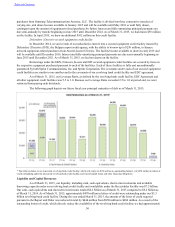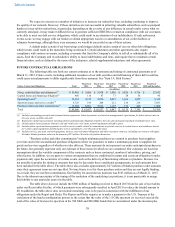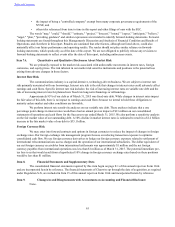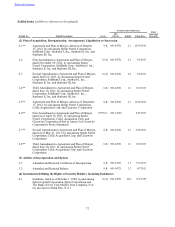Sprint - Nextel 2014 Annual Report Download - page 64
Download and view the complete annual report
Please find page 64 of the 2014 Sprint - Nextel annual report below. You can navigate through the pages in the report by either clicking on the pages listed below, or by using the keyword search tool below to find specific information within the annual report.
Table of Contents
62
payments, and the probability and timing of the trade-in. When the subscriber elects to exercise the trade-in right, the
difference between the outstanding balance of the installment receivable and the estimated fair value of the returned device is
recorded as a reduction of the guarantee liability. If the subscriber elects to stop purchasing the option prior to, or after,
becoming eligible to exercise the trade-in right, we recognize the amount of the associated guarantee liability as operating
revenue. At each reporting date, we reevaluate our estimate of the guarantee liability. If all subscribers, who elected the
option, were to claim their benefit at the earliest contractual time of eligible trade-in, the maximum amount of the guarantee
liability (i.e., the estimated unpaid balance of the subscribers' installment contracts) would be approximately $248 million at
March 31, 2015. This amount is not an indication of the Company's expected loss exposure because it does not consider the
expected fair value of the used handset, which is required to be returned to us in good working condition at trade-in, nor does
it consider the probability and timing of trade-in. The total guarantee liabilities associated with the option, which are recorded
in "Accrued expenses and other current liabilities" in the consolidated balance sheets, were immaterial.
NEW ACCOUNTING PRONOUNCEMENTS
In April 2014, the Financial Accounting Standards Board (FASB) issued authoritative guidance regarding
Reporting of Discontinued Operations and Disclosures of Disposals of Components of an Entity, which changes the criteria
for determining which disposals can be presented as discontinued operations and modifies related disclosure requirements.
The updated guidance defines discontinued operations as a disposal of a component or group of components that is disposed
of or is classified as held for sale and represents a strategic shift that has, or will have, a major effect on an entity’s operations
and financial results. Additionally, the disclosure requirements for discontinued operations were expanded and new
disclosures for individually significant dispositions that do not qualify as discontinued operations are required. The guidance
is effective prospectively for fiscal years and interim reporting periods within those years beginning after December 15, 2014,
with early adoption permitted for transactions that have not been reported in financial statements previously issued or
available for issuance. The standard will be effective for the Company's fiscal year beginning April 1, 2015 and will be
applied to relevant future transactions.
In May 2014, the FASB issued new authoritative literature, Revenue from Contracts with Customers. The issuance
is part of a joint effort by the FASB and the International Accounting Standards Board (IASB) to enhance financial reporting
by creating common revenue recognition guidance for U.S. GAAP and International Financial Reporting Standards and,
thereby, improving the consistency of requirements, comparability of practices and usefulness of disclosures. The new
standard will supersede much of the existing authoritative literature for revenue recognition. As currently written, the
standard and related amendments will be effective for the Company for its annual reporting period beginning April 1, 2017,
including interim periods within that reporting period, and early application is not permitted. In April 2015, the FASB issued
a proposal to defer the effective date of the new literature by one year but allow companies to early adopt according to the
original effective date. Entities are allowed to transition to the new standard by either retrospective application or recognizing
the cumulative effect. The Company is currently evaluating the newly issued guidance, including which transition approach
will be applied and the estimated impact it will have on our consolidated financial statements.
In June 2014, the FASB issued authoritative guidance regarding Compensation - Stock Compensation, which
provides guidance on how to treat performance targets that can be achieved after the requisite service period. The updated
guidance requires that a performance target that affects vesting and could be achieved after the requisite service period be
treated as a performance condition and accounted for under current guidance as opposed to a nonvesting condition that would
impact the grant-date fair value of the award. The guidance is effective for annual periods and interim periods within those
annual periods beginning after December 15, 2015 with early adoption permitted. Entities may apply the amendments either
(i) prospectively to all awards granted or modified after the effective date; or (ii) retrospectively to all awards with
performance targets that are outstanding as of the beginning of the earliest annual period presented in the financial statements
and to all new or modified awards thereafter with the cumulative effect as an adjustment to the opening retained earnings
balance as of the beginning of the earliest annual period presented. The Company does not expect the adoption of this
guidance to have a material effect on our consolidated financial statements.
In August 2014, the FASB issued authoritative guidance regarding Disclosure of Uncertainties about an Entity’s
Ability to Continue as a Going Concern, which requires management to assess an entity’s ability to continue as a going
concern and to provide related footnote disclosures in certain circumstances. The updated guidance requires management to
perform interim and annual assessments on whether there are conditions or events, considered in the aggregate, that raise
substantial doubt about an entity’s ability to continue as a going concern within one year after the date that the financial
statements are issued and to provide related disclosures, if required. The standard will be effective for the Company’s fiscal
























